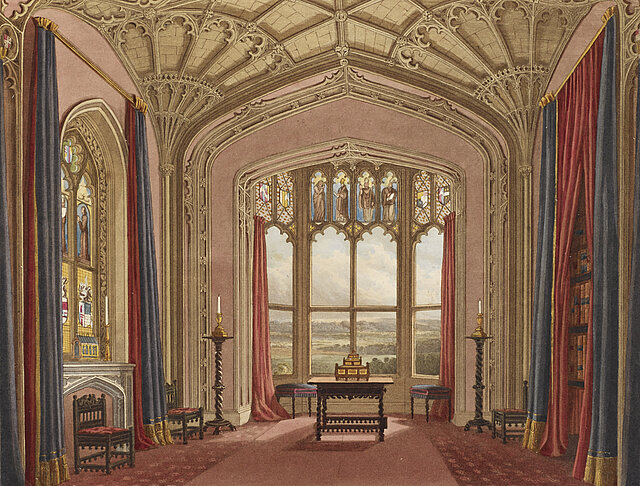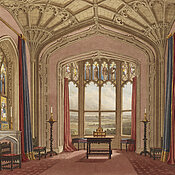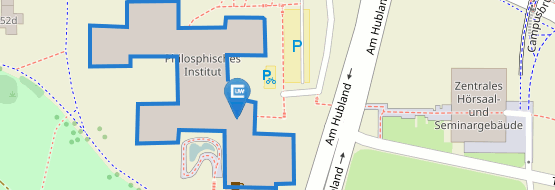Call for Papers: Gothic (Revival) Spaces: Konzepte und Interpretationen britischer und kontinentaler Wohnarchitektur zwischen 1750 und 1900
12.09.202314.–16. November 2024, Julius-Maximilians-Universität, Würzburg
English Version below
„Gothic spaces“ gehören in der Disziplin der englischsprachigen Literaturwissenschaft bei der Untersuchung des sogenannten „Schauerromans“ bzw. der „Gothic Novel“ mit seinen gotischen Motiven und Gestaltungselementen zu einem Kernbereich der Forschung. Im Mittelpunkt steht dabei vor allem die semiotische Struktur des Raums, der sowohl den Stimmungswert /Atmosphäre der Handlung festlegt als auch den Charakter und Verhaltensweisen der Protagonisten spiegelt. Die Betrachtung der architektonischen Struktur, eine Verortung und der Rezeptionskontext des Raumes wurden im Rahmen von literaturwissenschaftlichen Untersuchungen eher weniger beachtet. In der Kunstgeschichte hingegen spielt in der Auseinandersetzung mit neogotischen Bauwerken die Analyse von Formensprache, stilistische Bestimmung sowie die Zuordnung von Architekturvorbildern eine dominierende Rolle. Hingegen werden die Komplexität von Raumgefügen mit rekontextualisiertem gotischen Formenvokabular, deren Raumwirkung sowie soziale und performative Funktionen von Raum, insbesondere im Fall von Innenräumen, und ihren assoziativen und evokativen Qualitäten kaum berücksichtigt.
Ziel dieser Konferenz ist eine Gegenüberstellung von „fiktivem“, imaginiertem Raum der Literatur und „realem“ (gebautem oder im Entwurf fixiertem Architekturraum), denn dass die Entwicklung von fiktivem und materiell fassbarem „gotischen“ Raum fraglos zusammenhängen, wird bereits in einer ihrer gemeinsamen Wurzeln greifbar. Der englische Schriftsteller und Kunsthistoriker Horace Walpole (1717–1797) schrieb sich gleichermaßen mit der Erbauung seines „Gothic castle“ Strawberry Hill und der wohl ersten „Gothic Novel“, The Castle of Otranto (1764) in den literarischen wie architektonischen Kanon des 18. Jahrhunderts ein. Doch selbst hier, wo die gegenseitigen Bezüge von imaginiertem Raum im Roman und ausgeführtem Bauprojekt insbesondere durch schriftliche Quellen verbürgt sind, wäre eine vertiefte wissenschaftliche Auswertung wünschenswert.
Die Tagung möchte erstmalig mit einem transdisziplinären Austausch (insbesondere mit den Fachbereichen Literaturwissenschaft, Anglistik etc.) medial übergreifend Raumkonzepte des Gothic Revival untersuchen. Dabei soll der Frage nachgegangen werden, wie „Gothic space“ erfahrbar wird und wie er von anderer Raumwahrnehmung zu unterscheiden ist. Eine nähere Betrachtung macht hierbei die Asymmetrie von symbolischen Signifikaten von „Gothic“ (wie Beklemmung, Unterdrückung, Angst, Isolation, Zerfall und feudale Macht) und stilistisch-baulichen Assoziationen (wie traditionsreich, altehrwürdig, freiheitlich und national) notwendig. Da die Forschung schon lang erwiesen hat, dass Neogotik nicht einfach die Summe eines bestimmten Formenvokabulars (wie Spitzbögen, Glasfenster, Gewölbe und Maßwerk) darstellt, gilt es der Untersuchung von Raumsyntax und architektonischen sowie wirkungsästhetischen Qualitäten von Gotik, wie Transparenz, Vertikalismus und Organik, aber auch performativen und sozialen Funktionen von Raum gezielt Aufmerksamkeit zu schenken. Das Arrangement von Objekten und Möbeln im Raum ist im Zusammenhang mit dem strukturellen Raumentwurf als ein zentrales Gestaltungsmittel zu werten. Daher liegt der Fokus der Tagung auf dem privaten Repräsentations- und Wohnraum, der im Gegensatz zum sakral kodifizierten oder öffentlichen Raum eine höhere Variabilität und Vielfalt an Konzepten aufweist.
Mögliche Schwerpunktsetzungen für eine Präsentation der eigenen Forschungs-fragen könnten beispielsweise sein:
- Literarische und bauliche Konzepte gotischer Innenräume im Vergleich
- Verhältnis von gotischer Raumstruktur und Interieur
- Liminalität von Wohn-, Repräsentations- und privatem Sammlungsraum
- Konzepte von Historisierung und Authentizität
- Übersetzungsprozesse von sakralen Bauformen in „Domestic Gothic Space“
- Erzeugung und Rezeption von Stimmungswerten und Atmosphäre in neogotischen Räumen
- Einsatz von Materialität und Farbigkeit
- Gotische Wohnarchitektur in der Literatur/ fiktionale Räume als Metapher für das Unterbewusstsein
- Geschlechtsspezifische Rauminterpretationen
- Gärten und Landschaftsgestaltung als Erweiterung neogotischer Innenräume
Bitte senden Sie Ihren Vorschlag für einen 20-minütigen Vortrag (max. 300 Wörter) in deutscher oder englischer Sprache und einen kurzen CV bis zum 15. Oktober 2023 per E-Mail an:
daniela.roberts@uni-wuerzburg.de
christina.clausen@tu-darmstadt.de
Vorbehaltlich der Bewilligung der beantragten Mittel können Reise- und Übernachtungskosten (2. Klasse/Economy) erstattet werden.
Gothic (Revival) Spaces: Concepts and Reinterpretation of British and Continental Domestic Architecture 1750–1900
14–16 November 2024, Julius-Maximilians-Universität, Würzburg (Germany)
Critical engagements with so-called Gothic spaces in fiction is arguably one of many intellectual explorations in the field of Gothic Literature. These literary representations of space may emphasise the semiotic structure of fictional spaces in terms of plot, atmosphere and mood but they also reflect on characteristics and behavioural patterns of the narrative’s protagonists.
Until recently however, less sustained scholarly attention has been paid to the relationship between Gothic architecture and Gothic literature and the architectural style of the Middle Ages as prototype of the Gothic Revival space. In the discipline of art history, on the other hand, a critical focus on Neo-Gothic architecture that highlights design, styles and architectural precursors inhabits a much more prominent role. And yet one could argue that scholarly enquiries into the complexity of spatial structures and effects including the re-contextualised Gothic forms and features as well as the social and performative functions of spaces, especially Gothic Revival interiors and furniture, are yet to emerge.
With the conference “Gothic (Revival) Spaces” we would like to critically engage with the imaginary spaces in literature and the actually built or designed architectural spaces, since there’s little doubt that the evolution of the fictional and the tangible, material Gothic space is closely intertwined.
The English writer and antiquarian enthusiast for medieval art Horace Walpole (1717-1797) is best remembered for both the authorship of The Castle of Otranto: A Gothic Story (1764), as well as the creation of his “little Gothic Castle”, Strawberry Hill, regarded as one of the most important manifestations of the Gothic Revival.
Our conference seeks to encourage a transdisciplinary exchange of ideas and inquiries regarding architectural and interior concepts of Gothic Revival space. Addressing the issue of the perception of space, we will consider the particular and distinctive way in which Gothic space can be experienced. However, it also becomes evident that the term “Gothic” might imply symbolical signifiers (such as anxiety, oppression, isolation, disintegration and feudal power) mainly asymmetrical to stylistic connotations (such as lineage, venerability, liberty and national). As a number of studies have demonstrated that Gothic Revival cannot be simply described as the sum of architectural features, an assemblage of pointed arches, stained glass windows, vaults and tracery, it is indispensable to explore the structural order, performance and social role of Gothic space as well as the principles and aesthetic effects of Gothic Revival architecture. The arrangement of furniture and objects within a space as part of its structural layout is to be considered a core element of interior design.
In light of this complex backdrop the conference intends to put an emphasis on domestic space—which in comparison to many ecclesial and public spaces— shows a higher variability of individual concepts.
We invite papers that may include, but are not limited to, the following kind of emphasis:
- Comparing literary and architectural concepts of Gothic domestic spaces
- Relationship between Gothic spacial structure and interiors and interior design
- Liminality of domestic spaces as spaces of collection and representation
- Concepts of historicisation and authenticity
- Process of translating sacred design to domestic Gothic design
- Moods and atmosphere of Gothic spaces
- Materiality
- Fictional Gothic space or houses as a metaphor for the subconsciousness/ metaphoric use of fictional space
- models of domestic architecture in Gothic novels
- Gender specific Gothic spaces
- Gardens and landscapes as an extension of domestic Gothic space
Please email your abstract (300 words) together with your biography of approximately 150 words to Dr Daniela Roberts (daniela.roberts@uni-wuerzburg.de) and Christina Clausen M. A. (christina.clausen@tu-darmstadt.de), by 15 October 2023. All abstracts must be submitted and presented in German or English.
If funds are available, a travel allowance and accommodation expenses will be granted.







